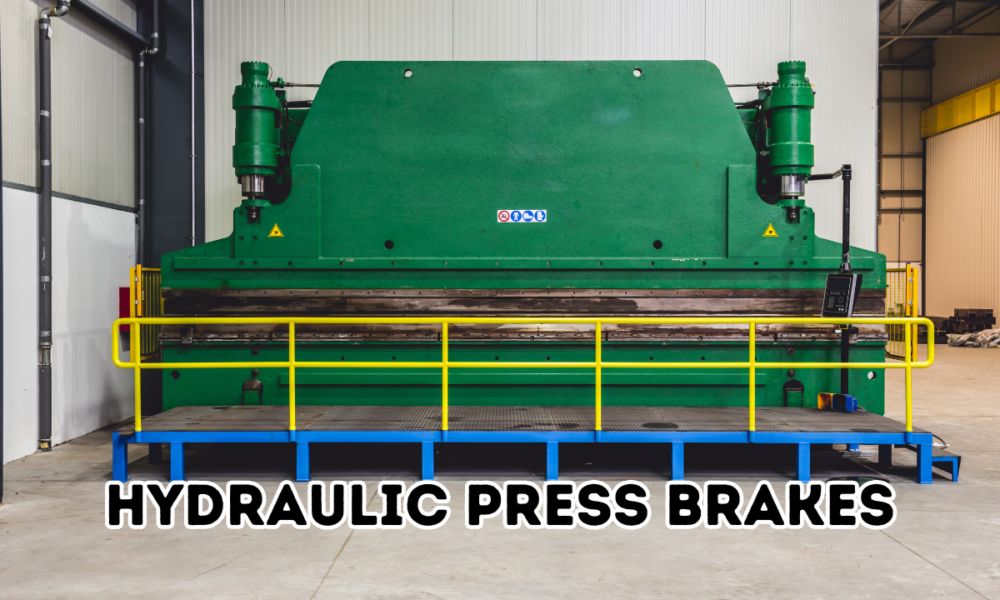Hydraulic Press Brakes: Essential Equipment for Business Success
Boosting Productivity and Efficiency in Metal Fabrication
Metal fabrication companies need to be precise and fast to compete. Accuracy and speed are crucial to success in this industry. Hydraulic press brakes have emerged as a vital solution, offering benefits that transform production processes. Some are the following:
1: Their versatility enables fabrication businesses to efficiently tackle a wide range of projects, from simple to complex.
2: Their efficiency reduces production time, allowing companies to complete projects faster and take on more work.
3: Their accuracy ensures precise bending and shaping, producing high-quality products with minimal errors.
Hydraulic press brakes can help metal fabrication businesses make better products faster and cheaper. This investment can improve production, product quality, and efficiency and reduce expenses. Hydraulic press brakes are vital for companies that want to stay ahead of the competition. With them, companies can achieve long-term success and grow their business. Learn more
Understanding Hydraulic Press Brakes
A hydraulic press brake is a sophisticated machine that plays a crucial role in metal fabrication. Its core consists of three main components: a hydraulic system, a press brake, and a control system. The hydraulic system is the power source, generating the force to bend and shape metal sheets. This force is then applied by the press brake, which is essentially a lever or piston that presses the metal against a die, creating the desired bend or shape. The control system is the brain of the operation, providing precise control over the bending process and ensuring accurate and consistent results. This includes programmable settings, automated cycles, and real-time monitoring, allowing operators to fine-tune the process and produce high-quality parts effortlessly. Hydraulic press brakes enable metal fabricators to create complex shapes and designs with precision, speed, and efficiency by integrating these components.
Key Benefits of Hydraulic Press Brakes
1. Precision and Efficiency
Hydraulic press brakes enable accurate and efficient metal fabrication, ensuring high-quality products and reduced production time. With their advanced control systems, these machines can achieve precise bends and angles, minimizing errors and waste.
2. Cost-Effectiveness
Hydraulic press brakes help businesses save resources and improve their bottom line by reducing labor costs and increasing productivity. They can also perform tasks that would otherwise require multiple machines, making them a cost-effective solution.
3. Versatility
Hydraulic press brakes can handle various metal types, thicknesses, and bending applications, making them a valuable asset for diverse manufacturing needs. They can be used in multiple industries, from automotive to aerospace.
Step-by-Step Guide to Using Hydraulic Press Brakes
Step 1: Prepare the Machine
– Inspect and maintain the hydraulic press brake to ensure optimal performance and longevity.
– Lubricate moving parts and components according to the manufacturer’s recommendations.
– Select the appropriate tooling and dies for the specific bending application, ensuring compatibility with the metal sheet’s thickness and material.
Step 2: Load the Metal Sheet
– Carefully place the metal sheet on the machine’s worktable, ensuring proper alignment with the press brake’s axis.
– Secure the metal sheet using clamps or other holding devices to prevent movement during bending.
Step 3: Set the Controls
– Enter the desired bend angle and pressure settings using the control system, which may include:
– Bend angle: Set the precise angle of the bend, considering the metal sheet’s thickness and material.
– Pressure settings: Adjust the hydraulic pressure to achieve the desired level of force for the bend.
Step 4: Perform the Bend
– The hydraulic system forces the metal sheet, bending it to the desired angle.
– The press brake’s ram or piston moves downward, applying pressure to the metal sheet forming around the die.
Step 5: Inspect and Repeat
– Inspect the bent metal for accuracy and quality, checking for:
– Bend angle accuracy
– Surface finish
– Any signs of deformation or damage
– Repeat the process for multiple bends or complex shapes, adjusting the controls and tooling as necessary.
Following these steps and ensuring proper machine maintenance, operators can achieve precise and consistent results when using hydraulic press brakes for metal fabrication. You can have complete guideline at https://miharmle-cnc.com/
Safety Precautions and Maintenance
Safety Precautions
– You should always wear protective gear, including gloves and safety glasses.
– Ensure proper training on machine operation and safety procedures.
Maintenance
– Regularly inspect and maintain the hydraulic, press brake, and control systems.
– Follow manufacturer guidelines for maintenance and restoration.
Investing in Hydraulic Press Brakes
When selecting a hydraulic press brake, consider the following factors:
Tonnage and Pressure:
Choose a machine with appropriate tonnage and pressure capacity for your specific needs, considering the thickness and type of materials you’ll be working with. Assessing the required tonnage ensures optimal performance and longevity of the machine.
Bed Size and Stroke:
Select a machine with a bed size and stroke that accommodates your most enormous metal sheets, ensuring versatility and efficiency in production. Understanding the typical dimensions of your workpieces is crucial to ensure the selected machine can effectively meet your bending requirements.
Control System and Tooling:
Opt for a machine with an advanced control system and versatile tooling options. These features enable precise control over the bending process and adaptability for various projects. They include features like programmable settings, automated cycles, and real-time monitoring.
Precision and Control:
Consider a machine’s bending accuracy and precision to ensure it meets your specific requirements. A machine with lower precision may result in rejected parts, emphasizing the importance of evaluating bending accuracy before purchase.
Speed and Productivity:
Evaluate the machine’s bending speed and productivity features. Hydraulic press brakes offer faster cycle times and rapid approach and retract speeds, increasing overall productivity.
Footprint and Space Requirements:
Ensure your workspace has sufficient space to accommodate the machine, considering its size and cargo requirements.
Energy Efficiency and Noise Levels:
Look for machines that use less energy and make less noise. This will help you save money on energy costs and create a more comfortable workspace. It’s also better for the environment and your workers’ well-being.
Maintenance and Support:
Buy from a trustworthy company that offers maintenance plans and technical support. This will help reduce breakdowns and keep your machine running.
Budget Considerations:
When buying a hydraulic press brake, consider the cost upfront and how much it will cost to maintain over time. Please ensure the machine’s benefits outweigh its costs and fit your budget.
Conclusion
Hydraulic press brakes are essential for metal fabrication businesses. They help businesses make things faster and better, making them an excellent investment for any metal fabrication company. Knowing how hydraulic press brakes work and their benefits helps companies make good choices, which can help them grow and succeed. Be safe when using your hydraulic press brake. Regular maintenance is essential to keep it working well. Proper training will help you use it correctly and make it last longer.







